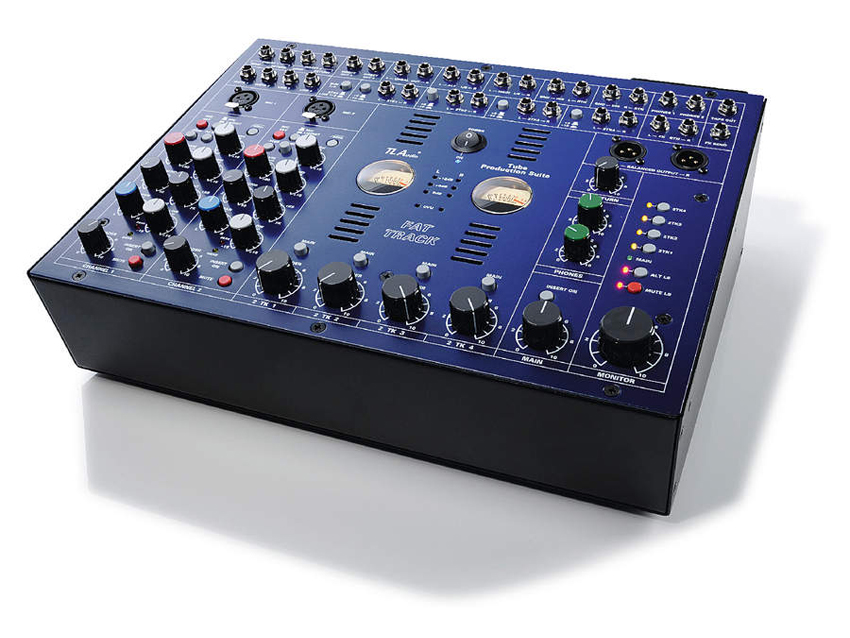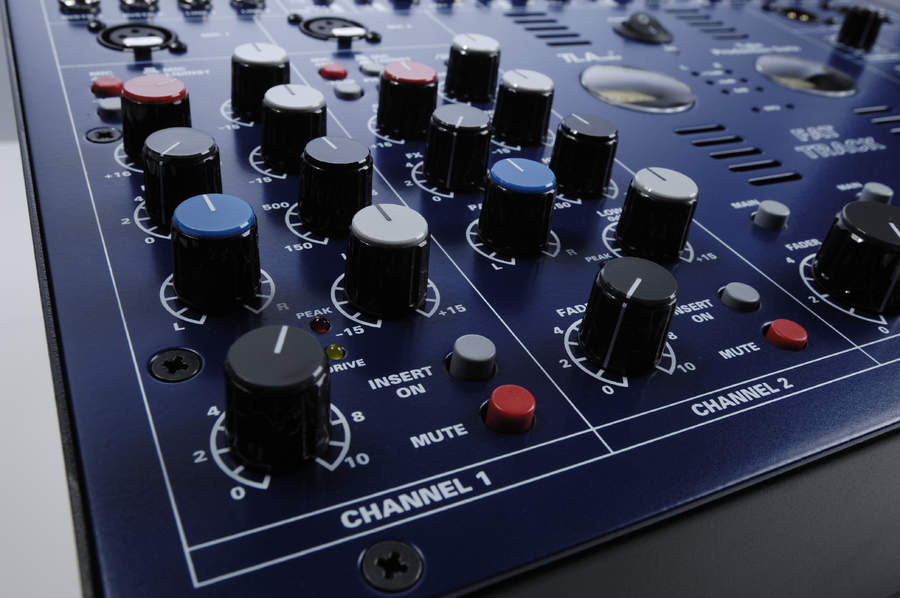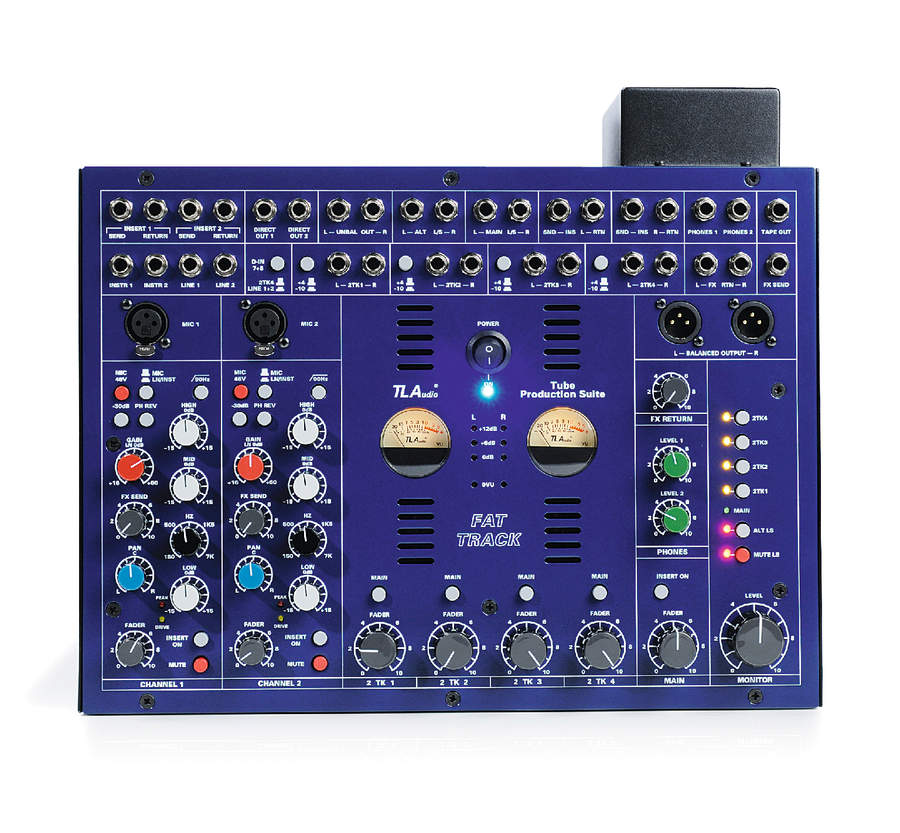MusicRadar Verdict
A flexible, sumptuous sounding studio companion with bags of personality. Computer-based producers should give it a very close look.
Pros
- +
Hugely flexible analogue I/O routing. Gorgeous tube preamps. Makes your mixes stand out.
Cons
- -
Patchbay section can get cluttered with cables.
MusicRadar's got your back

The Fat Track can make your mixes sound better - simple as that.

There are two tube-based input channels.

Cables are plugged in at the top of the panel.
It's no surprise that high-quality microphone preamps and top-end audio interfaces are returning to the shopping lists of producers everywhere.
TL Audio has a long-standing reputation for producing high-quality audio hardware. The Fat Track could be the solution for anyone who's seeking to put analogue warmth and flexibility at the heart of their digital studio.
So, what precisely does this rather attractive blue wedge offer? Well, it's billed as a 'Tube Production Suite' and provides a range of features designed to deal with a number of simultaneous signals received directly from your audio interface.
Overview
For starters, it offers a pair of tube-based input channels that can be used on a variety of input source types. Next come four independent, 2-track stereo inputs, which are designed to receive inputs from multi-channel audio interfaces or as tape returns, each with independent level controls and output routing options.
In the main output section, there's a comprehensive set of monitoring choices and the tube-driven signal path returns. This enables you to get a high-quality signal back into your DAW or directly to your stereo mastering machine of choice.
In short, this is a box for recording, summing a number of audio feeds, monitoring and doing a little mixing if the mood takes you.
To the left of the top panel lie the two mono preamp channels, which can accept levels from mic, line and instrument sources. Physical connections for all inputs are made at the back of the top panel and once you're connected, you can make appropriate settings for your chosen source.
Accordingly, phantom power is provided for mic inputs and a pad button gives a generous 30dB of gain reduction for loud input sources.
Below these switches, each channel has gain input, FX send and pan control rotary knobs. The fader is also a rotary design and sits at the bottom, with a 'Drive' LED to indicate signal presence and a further red 'Peak' light if levels are a little on the fiery side.
Each channel also has a dedicated EQ, with High, Low and sweepable mid-tone controls. There's also a high-pass filter button that can be used if you want to roll off frequencies below 90Hz, while an EQ bypass button can be used to miss this stage out altogether. You'll even find a dedicated Phase Reverse button on each channel input.
Without question, the single biggest sonic feature of working with this box is the now famous TL Audio Tube.
This adds boundless warmth and character; even passing a stereo mix from your DAW through these inputs and recording the result back into the computer provides an immediate sonic width and depth, all of which is rather glorious.
The top section of the front panel provides the patchbay through which all signals come and go.
The top row concerns itself primarily with outputs, featuring unbalanced outs, two sets of studio monitor outs, the effects send and return system and two independently driven headphone feeds. The full balanced outputs appear directly above the main output and monitor sections.
In the bottom row, you have access to the four stereo pairs of line sources, which feature +4/-10dB pad switches. These all have independent level faders at the bottom, which in turn feed independent 2-track busses in the monitor section.
Visual monitoring is a snap - each 2-track source has its own light, so you can easily switch between monitoring a particular source or listening to all sources if they're routed to the main stereo bus.
It goes without saying that, once you've hooked everything up, this patchbay quickly begins to resemble a busy telephone exchange.
With this in mind, we're surprised that TL Audio hasn't moved some connections to the amply sized rear panel.
We can appreciate that input sources may regularly change - so to keep these top-mounted makes some sense - but switching over monitor outputs and effects systems is likely to be less common, so getting these connections out of the way would certainly help.
The central section of the top panel concerns itself with the stereo VU meters, which are flanked by 'traffic light' LEDs for visual monitoring too. The inclusion of the latter seems a little cursory - producers who prefer LED level 'ladders' to VUs won't be best pleased.
In use
So, after the connections are all in, how does the Fat Track perform in the heat of the studio environment? Spectacularly well, as it transpires.
Having access to stereo groups of sound sources is glorious, for a start, and being able to feed separate pairs of monitors and independent headphone mixes for clients is great. But ultimately this box is all about the sound, and it's one well worth hearing.
Warmth is the standout feature - and we don't mean an artificial sense of brightness or 'saccharine sheen'. We're talking depth and width, which are much harder to replicate directly inside a DAW with plug-ins.
The Fat Track quickly starts to feel like it's almost an extension of the computer, and if you're in the habit of bouncing your audio in real time anyway, no time is lost sending your signal out through the Fat Track and back in on a spare pair of inputs.
The benefits of working entirely in the software domain are well documented. However, working with music technology used to be all about trying to present something different to everything else out there, and this is much harder if you're using the same software as a million other people.
The Fat Track is part of a new generation of hardware products that isn't trying to wrestle you away from your computer, but rather to make you realise that there's more to life than internal bouncing.
Passing your mix elements through a real signal path will change them, it's as simple as that. Passing them through components of this quality may well change them for the better and, as a result, lift the sonics of your production work far above those of others.
Certainly, if these concepts appeal, you should check the Fat Track out immediately. It has a sonic heart of pure gold and is ready to be the mixer you thought you'd never need again.
Running full pelt, the patchbay section begins to resemble Piccadilly Circus, but if you can get all of those trailing cables to head in the right direction, you're left with a unit that can take a full complement of inputs and modify the quality of their signals in meaningful, musically rewarding ways.
Future Music is the number one magazine for today's producers. Packed with technique and technology we'll help you make great new music. All-access artist interviews, in-depth gear reviews, essential production tutorials and much more. Every marvellous monthly edition features reliable reviews of the latest and greatest hardware and software technology and techniques, unparalleled advice, in-depth interviews, sensational free samples and so much more to improve the experience and outcome of your music-making.
“The EP635 delivers the unmistakable high-gain aggression and clarity that Engl fans love”: Engl packs its iconic Fireball head into a compact dual-channel stompbox with onboard noise gate and IR support
"There had to be some sort of telepathy going on because I've never seen spontaneous inspiration happen at that level”: The genius of Eric Clapton's controversial masterpiece, Layla
"I said, ‘What’s that?!’ He looked at me strange and said, ‘We’re line checking. We’ll be gone in five minutes’. I said, ‘You won’t - meet me in that room in 10 minutes’": How a happy synth accident inspired a US number 1 single for Terence Trent D’Arby










